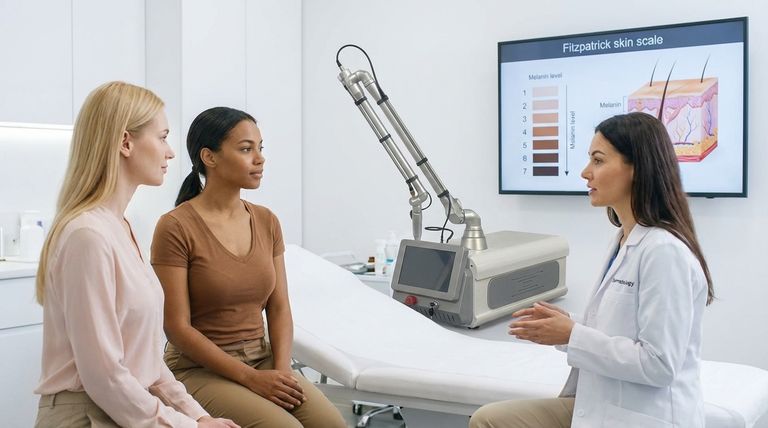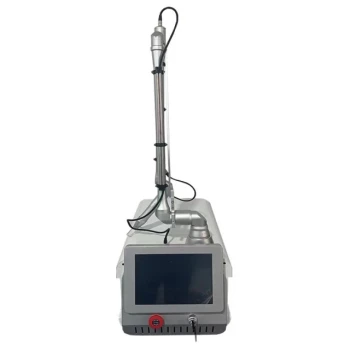While the technology exists to use CO2 lasers on all skin types, they are not a universally safe or recommended option for everyone. The ideal candidates have lighter skin tones (Fitzpatrick types I-III), as the risk of significant complications like permanent pigmentation changes and scarring increases dramatically for individuals with darker, melanin-rich skin (Fitzpatrick types IV-VI).
The fundamental challenge with CO2 lasers is that their powerful energy is designed to be absorbed by water in the skin, but it can also be absorbed by melanin (pigment). For darker skin tones, this creates a high-stakes balancing act: achieving the desired skin resurfacing without causing unintended and sometimes permanent damage to the skin's natural pigment.

Why Skin Type Is the Critical Factor
To understand the risks, we must first understand how the laser interacts with different components of the skin. The entire decision-making process hinges on one key variable: the amount of melanin in the epidermis.
The Fitzpatrick Scale: A Clinical Standard
Dermatologists use the Fitzpatrick scale to classify skin type. It ranges from Type I (very fair, always burns, never tans) to Type VI (deeply pigmented, never burns). This scale predicts the skin's likely reaction to ultraviolet light and, by extension, to heat-based energy treatments like lasers.
The Laser's Target: Water and Melanin
Ablative CO2 lasers work by delivering intense light energy that is strongly absorbed by water. Because skin cells are mostly water, the laser instantly vaporizes microscopic columns of tissue. This controlled injury triggers a powerful healing response, generating new collagen and resulting in smoother, tighter skin.
The problem is that this energy can also be absorbed by melanin.
The Low Risk for Lighter Skin (Types I-III)
In individuals with less melanin, the laser's energy has a clear and predictable target: the water in the skin cells. The risk of the energy being "stolen" by pigment is low, allowing for more aggressive and effective treatment with a lower probability of pigment-related side effects.
The High Risk for Darker Skin (Types IV-VI)
In skin with a high concentration of melanin, the pigment acts as a competing target for the laser's energy. This absorption of energy by melanin can rapidly overheat the pigment-producing cells (melanocytes), leading to unpredictable and often severe side effects.
How Modern Technology Mitigates Risk (But Doesn't Eliminate It)
While the risks are significant, advancements in laser technology have made treatment possible for some darker skin types, provided it's done under highly specific conditions.
The Role of Fractionated Lasers
Modern CO2 lasers are almost always fractionated. Instead of treating 100% of the skin's surface, a fractionated laser creates a grid of microscopic treatment zones while leaving the surrounding tissue intact. These islands of untreated skin act as a reservoir for healing, dramatically reducing downtime and the overall thermal load on the skin. This is a critical safety feature for all skin types, but it is absolutely essential for darker skin.
Careful Adjustment of Parameters
For darker skin tones, a practitioner must use more conservative settings. This means lowering the laser's energy (fluence) and using shorter pulse durations to deliver heat very quickly, minimizing the time it has to spread and damage surrounding melanocytes. This requires a deep understanding of laser physics and tissue interaction.
The Operator's Skill Is Paramount
Technology alone does not guarantee a safe outcome. The single most important factor in the safe treatment of darker skin with a CO2 laser is the skill, training, and experience of the operator. A qualified practitioner will know when the risks are too high and when to recommend a different procedure altogether.
Understanding the Trade-offs and Potential Complications
Treating darker skin types with a CO2 laser is an "expert-level" procedure with a narrow margin for error. The potential rewards must be weighed carefully against the following risks.
Post-Inflammatory Hyperpigmentation (PIH)
This is the most common major complication. It manifests as dark patches on the skin in the treated areas. While sometimes temporary, it can last for many months and require extensive treatment to resolve.
Hypopigmentation
Arguably a more devastating complication, hypopigmentation is the permanent loss of skin color. The laser energy destroys the melanocytes, leaving white spots or patches that are extremely difficult, if not impossible, to correct.
Increased Risk of Scarring
If the thermal injury is not perfectly controlled, it can overwhelm the skin's healing capacity and lead to the formation of keloid or hypertrophic scars.
Prolonged Healing
Even with a perfect procedure, darker skin types often experience more prolonged redness (erythema) and a more complex healing phase compared to lighter skin types.
Making the Right Choice for Your Skin
Your decision should be based on a combination of your skin type, your treatment goals, and your tolerance for risk.
- If you have Fitzpatrick Skin Type I-III (fair to light olive skin): You are generally a good candidate for CO2 laser, but a consultation with a board-certified dermatologist is still essential to assess your specific condition.
- If you have Fitzpatrick Skin Type IV-VI (medium brown to deeply pigmented skin): You face significantly higher risks and must exercise extreme caution. Only consider this treatment with a top-tier expert who has demonstrable experience treating skin of color with fractionated CO2 lasers.
- If your primary focus is safety over dramatic results: You should strongly consider alternatives with a better safety profile for darker skin, such as microneedling with radiofrequency, gentler non-ablative lasers, or specific chemical peels.
Ultimately, a successful outcome depends on a candid assessment of your personal risk and the proven expertise of your chosen practitioner.
Summary Table:
| Fitzpatrick Skin Type | Risk Level for CO2 Laser | Key Considerations |
|---|---|---|
| I-III (Fair to Light Olive) | Low to Moderate | Generally good candidates. Lower risk of pigment complications. |
| IV-VI (Medium Brown to Dark) | High to Very High | High risk of hyperpigmentation, hypopigmentation, and scarring. Requires expert-level treatment. |
Choose Safety and Precision for Your Practice
Navigating the complexities of CO2 laser treatments for diverse skin types requires not just expertise, but also the right technology. BELIS specializes in providing medical aesthetics clinics and premium beauty salons with professional, advanced equipment designed for efficacy and patient safety.
By partnering with BELIS, you gain access to:
- Precision Technology: Equipment with customizable settings to tailor treatments for different Fitzpatrick skin types.
- Enhanced Safety Profiles: Advanced features that help minimize risks like hyperpigmentation.
- Professional Support: Expert guidance to integrate the best technology for your practice's needs.
Ensure your clinic offers the highest standard of care. Contact our specialists today to find the ideal laser solution for your clientele.
Visual Guide

Related Products
- Fractional CO2 Laser Machine for Skin Treatment
- Fractional CO2 Laser Machine for Skin Treatment
- Pico Picosecond Laser Machine for Tattoo Removal Picosure Pico Laser
- Clinic Diode Laser Hair Removal Machine with SHR and Trilaser Technology
- Diode Laser SHR Trilaser Hair Removal Machine for Clinic Use
People Also Ask
- How often should you do fractional CO2 laser? The 4-6 Week Rule for Optimal Results
- What are the advantages of laser in the medical field? Precision, Recovery, and Drug-Free Solutions
- What does a CO2 laser do to your face? Achieve Profound Skin Resurfacing & Renewal
- What are medical lasers used for? Precision Tools for Surgery and Skin Treatments
- What is a fractional CO2 laser machine used for? A Guide to Advanced Skin Resurfacing



















